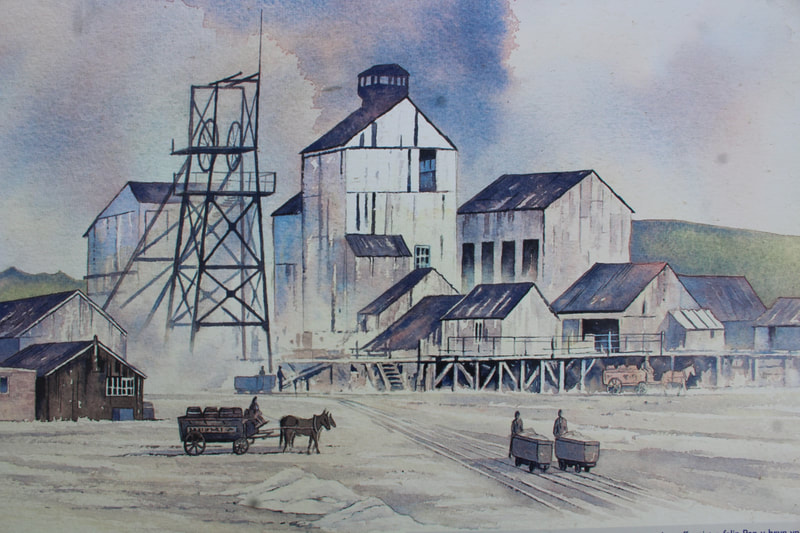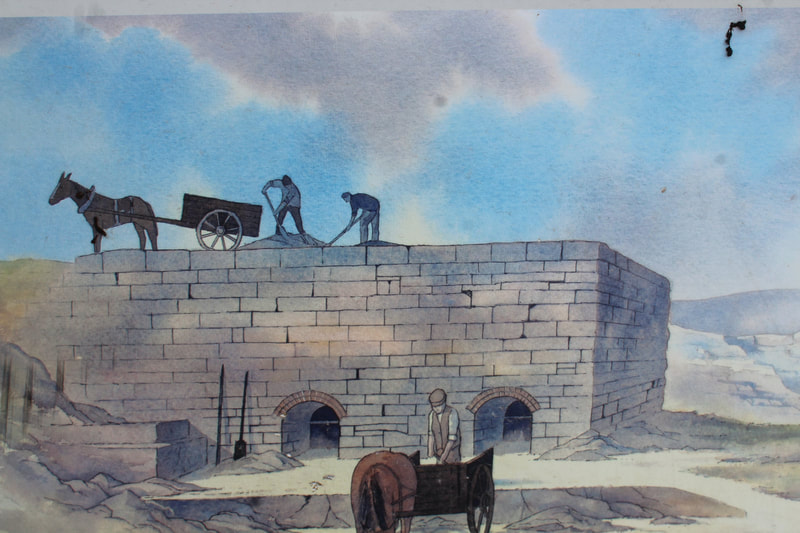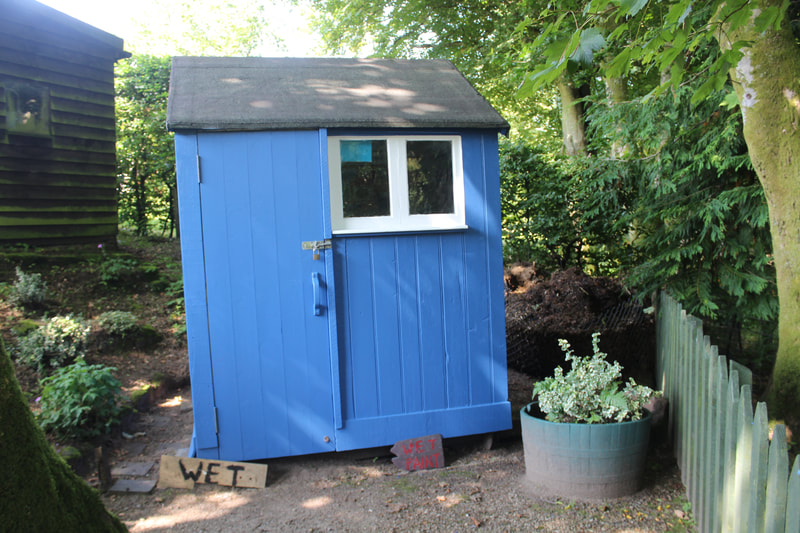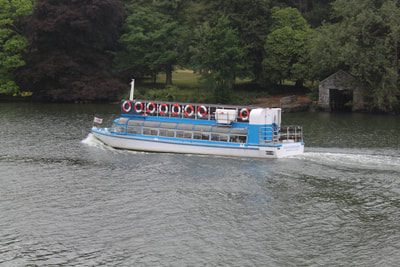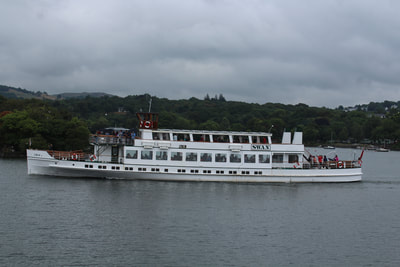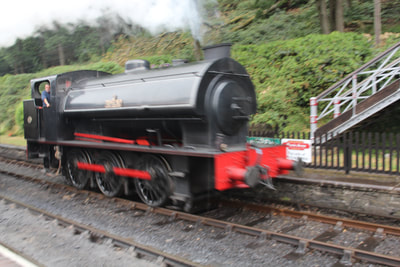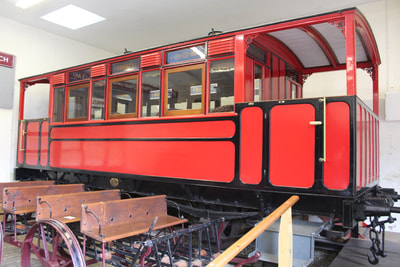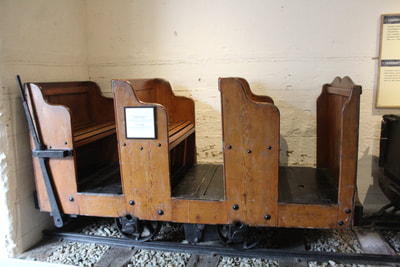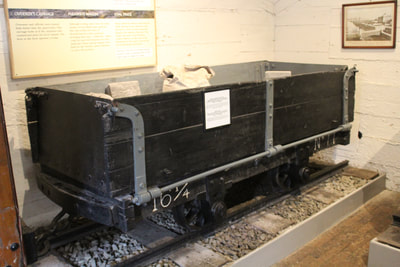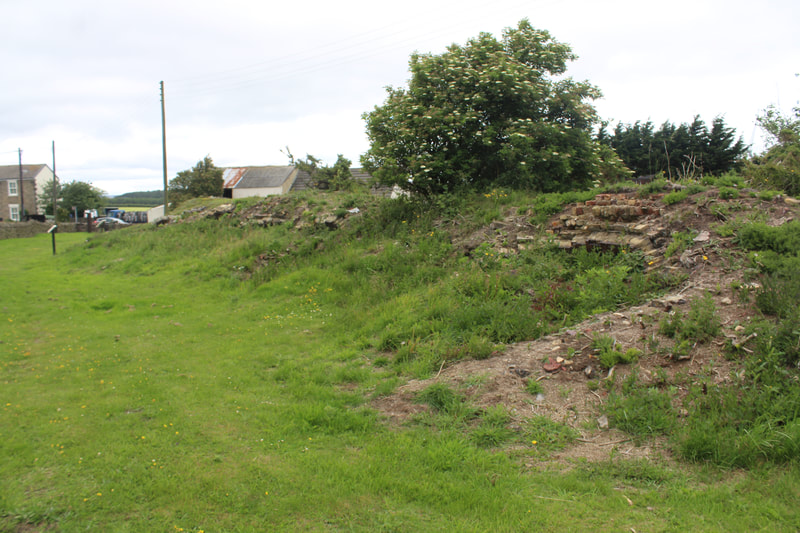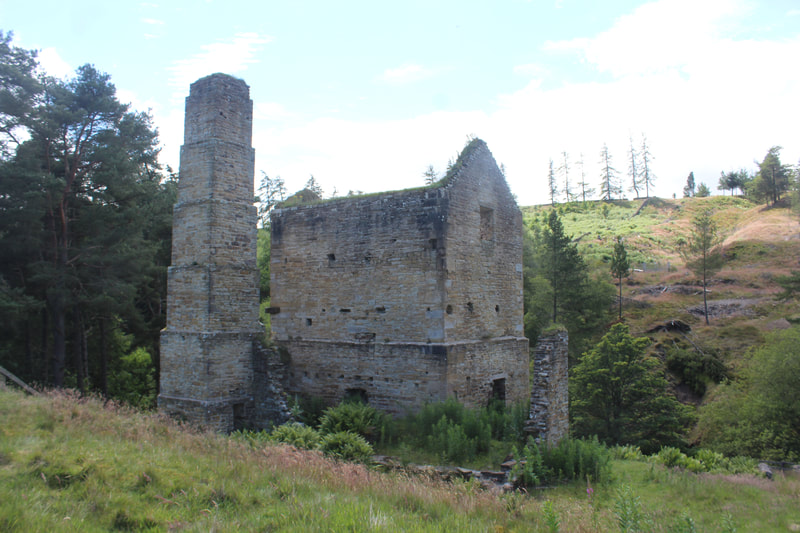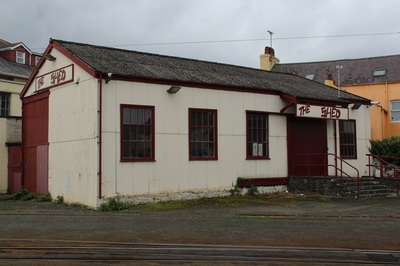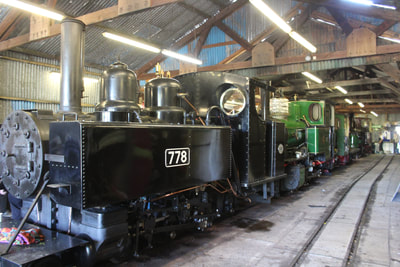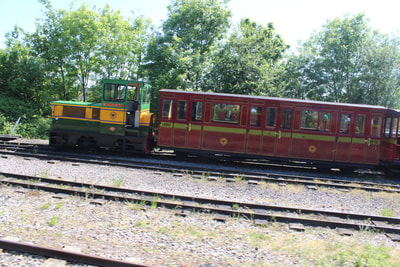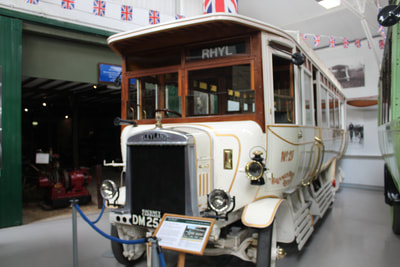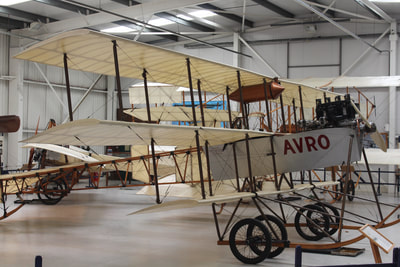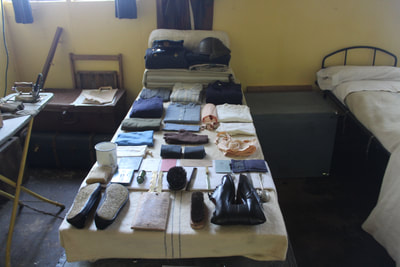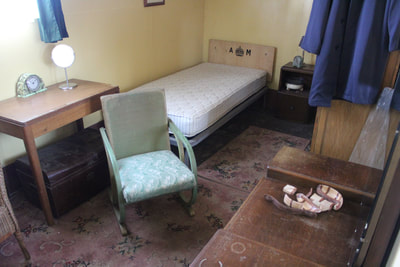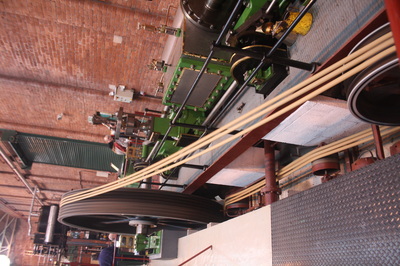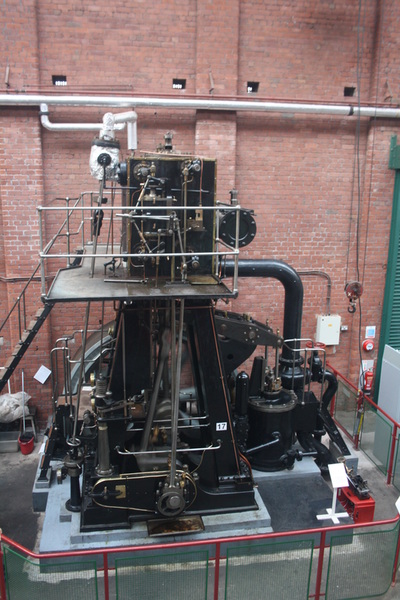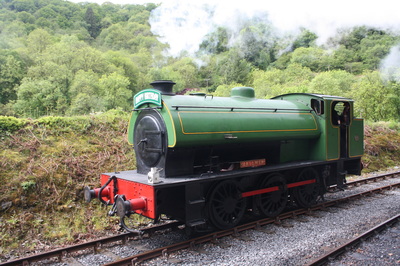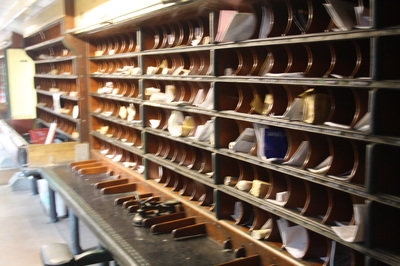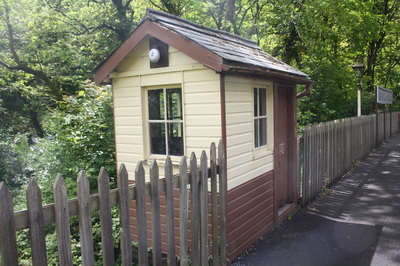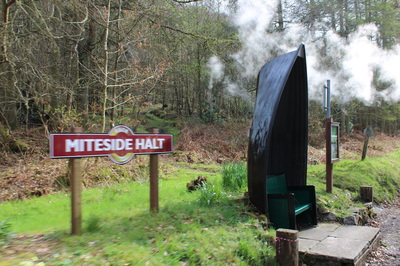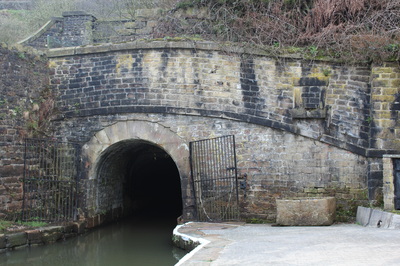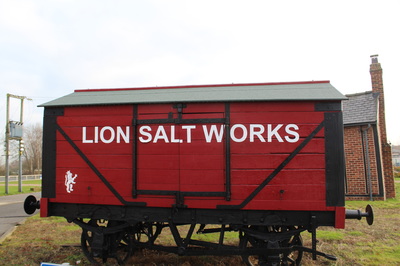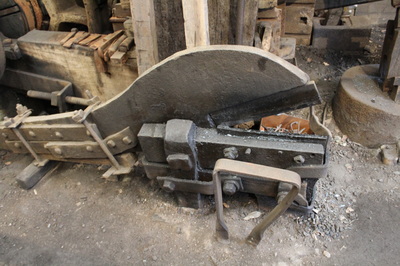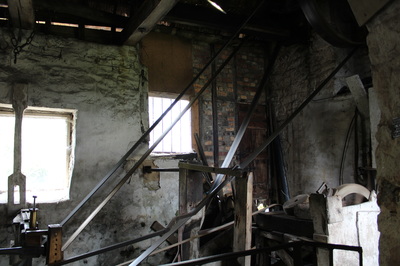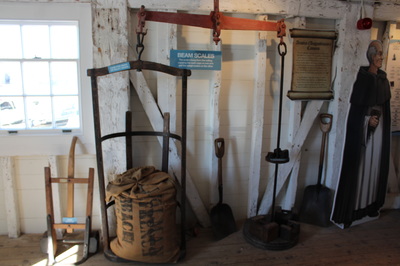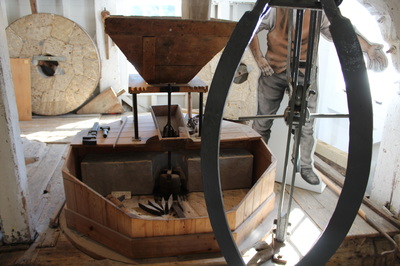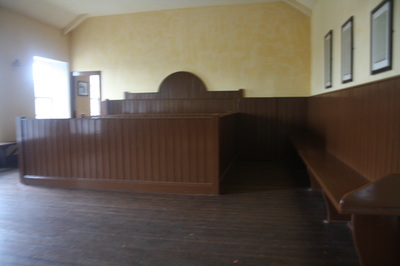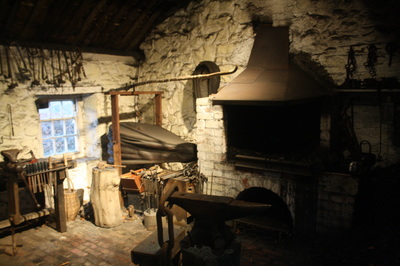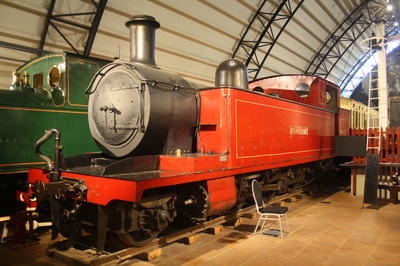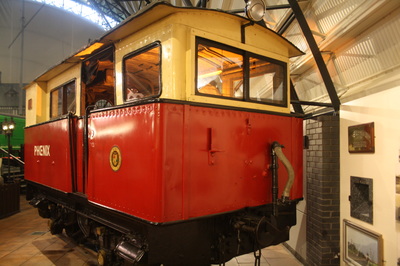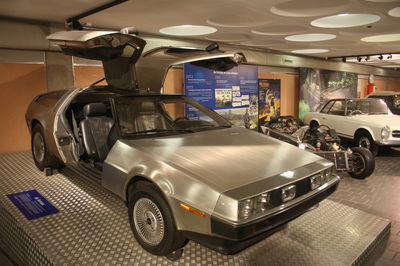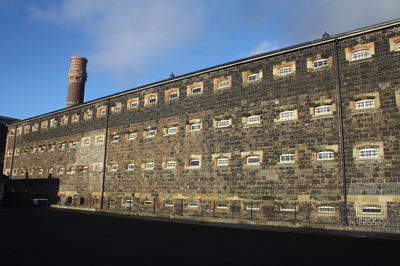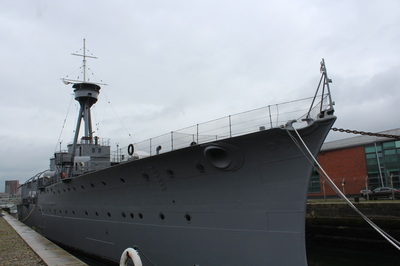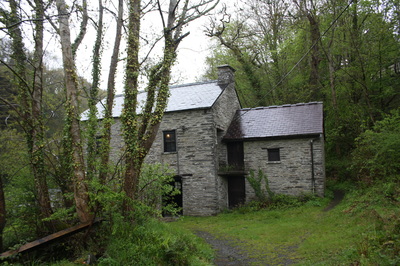Peter's Wanderings
Photographs and notes on Interesting Places visited by our Chairman Peter Purland
HALKIN MOUNTAIN 2021
In 2021 I visited Halkyn Mountain where we had a field trip a few years back. I confess I cannot find any photos of that trip. However on a recent trip after we were allowed back in to Wales I took some photos. It remains a very interesting area and Flintshire are improving the interpretation.
The last lead mines closed in 1987 and the Pen-y-Bryn works were dismantled very soon afterwards There is, however, a large working quarry (Limestone) at Pant-y-Pwll Dwr which, along with other quarries supplies a million tons of stone and aggregates to North Wales and the North West of England each year.
The two Lime Kilns shown were very different in their uses. The Rhes-y-Cae kilns produced lime for the local agricultural industry whilst the Waen-y-Brodlas kilns produced hydraulic lime which was use in dock construction in Liverpool, Birkenhead and Belfast. Lime burning on Halkyn Mountain finished about 1914. There is a website on Halkyn Mountain which is being built up into a very good resource.
Hover over images for captions.
In 2021 I visited Halkyn Mountain where we had a field trip a few years back. I confess I cannot find any photos of that trip. However on a recent trip after we were allowed back in to Wales I took some photos. It remains a very interesting area and Flintshire are improving the interpretation.
The last lead mines closed in 1987 and the Pen-y-Bryn works were dismantled very soon afterwards There is, however, a large working quarry (Limestone) at Pant-y-Pwll Dwr which, along with other quarries supplies a million tons of stone and aggregates to North Wales and the North West of England each year.
The two Lime Kilns shown were very different in their uses. The Rhes-y-Cae kilns produced lime for the local agricultural industry whilst the Waen-y-Brodlas kilns produced hydraulic lime which was use in dock construction in Liverpool, Birkenhead and Belfast. Lime burning on Halkyn Mountain finished about 1914. There is a website on Halkyn Mountain which is being built up into a very good resource.
Hover over images for captions.
VISIT TO ARRAN AND AYRSHIRE
WINDERMERE and PENRHYN CASTLE 2018
During July I have had a couple of trips which have included an IA element. I did a World Ship Society Merseyside Branch trip to Lakeside from where I got an all day ticket on the steamers and also had a round trip on the Lakeside and Haverthwaite Railway. The three large steamers are Tern 1891 built by Forrest and Sons Wivenhoe, Teal 1936 and Swan 1938 both built by Vickers at Barrow. All three were brought to Lakeside where they were assembled. They are all on the National Register of Historic Ships.. The launch Silverdale dates from 1969 The first steamer, Lady of the Lake was launched in 1845 and regular services have existed since that date. Today there are no freight services but there are regular steamer and launch services to islands and places of interest around the lake.
The Lakeside Branch of the Furness Railway was opened to Newby Bridge in 1869 and extended to Lakeside in 1871. It was closed in 1965 to passengers (since WWII there had only been a summer service) and to freight two years later. It was reopened by enthusiasts in 1973 from Haverthwaite to Lakeside but the southern section is now the A490 trunk road. The two engines both date from 1950 and are in regular service.
The industrial railway museum at Penrhyn Castle was founded in 1951 and has a good collection of mostly local exhibits. I have photographed 6 of the less well known and they are as follows Watkin was built in 1893 for Penmaenmawr Granite Quarries to 3 foot guage. The Velocipede was 4 foot guage and ran on the Padarn Railway. The Directors' Coach of 1896 is also from the Padarn Railway. The Nantlle Tramway Wagon was owned by Pen - yr - orsedd Quarries and was mostly used internally whilst the overseers coach and the fullerite wagon were from the Penrhyn Railway,
Hover over images for captions.
During July I have had a couple of trips which have included an IA element. I did a World Ship Society Merseyside Branch trip to Lakeside from where I got an all day ticket on the steamers and also had a round trip on the Lakeside and Haverthwaite Railway. The three large steamers are Tern 1891 built by Forrest and Sons Wivenhoe, Teal 1936 and Swan 1938 both built by Vickers at Barrow. All three were brought to Lakeside where they were assembled. They are all on the National Register of Historic Ships.. The launch Silverdale dates from 1969 The first steamer, Lady of the Lake was launched in 1845 and regular services have existed since that date. Today there are no freight services but there are regular steamer and launch services to islands and places of interest around the lake.
The Lakeside Branch of the Furness Railway was opened to Newby Bridge in 1869 and extended to Lakeside in 1871. It was closed in 1965 to passengers (since WWII there had only been a summer service) and to freight two years later. It was reopened by enthusiasts in 1973 from Haverthwaite to Lakeside but the southern section is now the A490 trunk road. The two engines both date from 1950 and are in regular service.
The industrial railway museum at Penrhyn Castle was founded in 1951 and has a good collection of mostly local exhibits. I have photographed 6 of the less well known and they are as follows Watkin was built in 1893 for Penmaenmawr Granite Quarries to 3 foot guage. The Velocipede was 4 foot guage and ran on the Padarn Railway. The Directors' Coach of 1896 is also from the Padarn Railway. The Nantlle Tramway Wagon was owned by Pen - yr - orsedd Quarries and was mostly used internally whilst the overseers coach and the fullerite wagon were from the Penrhyn Railway,
Hover over images for captions.
VISIT TO DURHAM AND NORTHUMBERLAND
I managed to escape Wallasey and had five days in County Durham and surrounds. Although th idea was mostly to see English Heritage sites I did come across some IA. The first two photos below show the Inkerman Coke Ovens which date from about 1840 and are some of the few remaining of what were once 14000 in County Durham.
The Shildon Engine House is above Blanchland (a very pretty village) It was built around 1805 to house a Cornish pumping engine, which kept the network of lead mines operating underneath from flooding. Towards the end of its industrial life in the 1840s, an enormous steam engine was installed in a final attempt to keep the mines dry enough to work. Following decommissioning, the engine house was converted to a series of flats for mining families. It was finally abandoned around 100 years ago and has been derelict ever since.
The Thorngreen Lime Kilns are located on the side of Slag Hill above Middlehope Burn, just north west of Allenheads in Northumberland. The lime kilns were worked until the mid 20th century and in the past a short length of tramway connected the kilns to Thorn Green Quarry to the north. In 2010 Natural England undertook work to help preserve the kilns They are some of the largest and best preserved lime kilns in the region, and are Grade II listed.
My final IA stop was in Allenheads where I was able to see part of the Lead Mining Works. The bouse teams (tall stone containers) are constructed of squared rubble and consist of 14 apsidal bays separated by stepped walls. These were used to store the newly mined lead ore prior to processing. Some of the bays still carry the remains of large timbers which formed part of a tramway, along which the lead ore was carried in trucks for tipping. At the northern end of the bouse teams there are the remains of a stone arched drainage tunnel; a paved and walled channel 70m long emerges from the tunnel and carries water from the Fawside level to the river at the south western part of the monument. To the west of the bouse teams there are the earthwork remains of the associated dressing floors on which many of the ore processing operations, intended to wash and sort the ore from unwanted impurities, were carried out. All work associated with lead mining ceased on this site in 1896.
Hover over images for captions.
I managed to escape Wallasey and had five days in County Durham and surrounds. Although th idea was mostly to see English Heritage sites I did come across some IA. The first two photos below show the Inkerman Coke Ovens which date from about 1840 and are some of the few remaining of what were once 14000 in County Durham.
The Shildon Engine House is above Blanchland (a very pretty village) It was built around 1805 to house a Cornish pumping engine, which kept the network of lead mines operating underneath from flooding. Towards the end of its industrial life in the 1840s, an enormous steam engine was installed in a final attempt to keep the mines dry enough to work. Following decommissioning, the engine house was converted to a series of flats for mining families. It was finally abandoned around 100 years ago and has been derelict ever since.
The Thorngreen Lime Kilns are located on the side of Slag Hill above Middlehope Burn, just north west of Allenheads in Northumberland. The lime kilns were worked until the mid 20th century and in the past a short length of tramway connected the kilns to Thorn Green Quarry to the north. In 2010 Natural England undertook work to help preserve the kilns They are some of the largest and best preserved lime kilns in the region, and are Grade II listed.
My final IA stop was in Allenheads where I was able to see part of the Lead Mining Works. The bouse teams (tall stone containers) are constructed of squared rubble and consist of 14 apsidal bays separated by stepped walls. These were used to store the newly mined lead ore prior to processing. Some of the bays still carry the remains of large timbers which formed part of a tramway, along which the lead ore was carried in trucks for tipping. At the northern end of the bouse teams there are the remains of a stone arched drainage tunnel; a paved and walled channel 70m long emerges from the tunnel and carries water from the Fawside level to the river at the south western part of the monument. To the west of the bouse teams there are the earthwork remains of the associated dressing floors on which many of the ore processing operations, intended to wash and sort the ore from unwanted impurities, were carried out. All work associated with lead mining ceased on this site in 1896.
Hover over images for captions.
ISLE OF MAN RAILWAYS - OCTOBER 2016
Each October I visit to work at the Isle of Man International Chess Tournament. Once it is underway I can often have 3 hours off in the morning I wanted to get a full view from the top of Snaefell so did two runs up the Manx Electric. The first time I continued from Laxey to Ramsey but the second time I got to the top and was able to see all 6 kingdoms although not the Principality.
The first great pleasure I had was seeing a horse tram trotting down the promenade and, now it is owned by Isle of Man Railways it is running through until the end of October albeit Wed, Sat and Sun only in October. Even so I was able to have a journey down the promenade. My first 5 photos are of the steam railway, electric railway (power car and trailer), Snaefell Mountain Railway and a horse tram. I also decided to take some stations and sheds to add to my views of the actual traction.
Some notes on the Photos. (4) Snaefell Mountain Railway No 1 is no older than the others but has been repainted in the original colour scheme and wording. (6) The Strathallan Suite was originally the Horse Tram Depot. (7) The original booking office of 1897. To say the facilities are basic is an understatement. The Terminus has never had toilets!! (8)The first terminus of the M.E.R, Groudle Glen is blessed with a large wooden waiting shelter and postbox. The station is also the interchange for the Groudle Glen Railway, which runs during the summer months from Lhen Coan to the cliffs at Sea Lion Rocks. I have been on an evening excursion from Douglas carrying well over 100 people. (9) This stop serves the small village of the same name, and is fitted with a corrugated iron shelter, with hanging baskets and tubs tended to by the local community. (10)
Laxey is the interchange for the Snaefell Mountain Railway, which shares the area and runs to the larger gauge of 3ft 6, with the need to accommodate the central rail. The station also has a building housing a booking office for both M.E.R and S.M.R trips, along with a small cafe and toilets. (11) Ramsey is the northern terminus of the Manx Electric Railway. The station boasts a brick building, built in 1963, which houses the station masters office, waiting area and toilets. (12) The goods shed was formerly the home to a museum, now converted into a youth drop-in centre, ‘The Shed’.
Each October I visit to work at the Isle of Man International Chess Tournament. Once it is underway I can often have 3 hours off in the morning I wanted to get a full view from the top of Snaefell so did two runs up the Manx Electric. The first time I continued from Laxey to Ramsey but the second time I got to the top and was able to see all 6 kingdoms although not the Principality.
The first great pleasure I had was seeing a horse tram trotting down the promenade and, now it is owned by Isle of Man Railways it is running through until the end of October albeit Wed, Sat and Sun only in October. Even so I was able to have a journey down the promenade. My first 5 photos are of the steam railway, electric railway (power car and trailer), Snaefell Mountain Railway and a horse tram. I also decided to take some stations and sheds to add to my views of the actual traction.
Some notes on the Photos. (4) Snaefell Mountain Railway No 1 is no older than the others but has been repainted in the original colour scheme and wording. (6) The Strathallan Suite was originally the Horse Tram Depot. (7) The original booking office of 1897. To say the facilities are basic is an understatement. The Terminus has never had toilets!! (8)The first terminus of the M.E.R, Groudle Glen is blessed with a large wooden waiting shelter and postbox. The station is also the interchange for the Groudle Glen Railway, which runs during the summer months from Lhen Coan to the cliffs at Sea Lion Rocks. I have been on an evening excursion from Douglas carrying well over 100 people. (9) This stop serves the small village of the same name, and is fitted with a corrugated iron shelter, with hanging baskets and tubs tended to by the local community. (10)
Laxey is the interchange for the Snaefell Mountain Railway, which shares the area and runs to the larger gauge of 3ft 6, with the need to accommodate the central rail. The station also has a building housing a booking office for both M.E.R and S.M.R trips, along with a small cafe and toilets. (11) Ramsey is the northern terminus of the Manx Electric Railway. The station boasts a brick building, built in 1963, which houses the station masters office, waiting area and toilets. (12) The goods shed was formerly the home to a museum, now converted into a youth drop-in centre, ‘The Shed’.
TRANSPORT TRUST MEMBERS' WEEKEND & AGM 2016
Peter's report on the Transport Trust Weekend in 2016
As with the MIHS the Transport Trust have a members weekend around their AGM. It follows a similar programme to ours with visits and speakers and is based at a hotel. This year the event was based at the Park Inn Bedford.
We met on the Friday afternoon at the Summerfields Railway which is run by the Bedford Model Engineering Society. They have a track running on land rented from the Whitbread Family (no longer brewers) and they have an 1800 foot 7.5 inch miniature track from Haynes End to Hammerhill Junction. At the latter they have a 3.5 and 5 inch raised track running in a circle as well as a garden railway. We had plenty of rides over all parts of the main track with 3 engines running Skylark (battery), Lewis (Diesel electric) and Lady Margaret (Steam) and afterwards we had a talk about the railway by the president. In the evening we had an interesting talk by Jane Hamilton from the Bedford and Milton Keynes Waterways Trust. They are committed to closing the gap between the Great Ouse and the Grand Union. She was interesting and dedicated.
Saturday We had the AGM which lasted 45 minutes (apparently a record length) after which we had a short walk along the river and waited for the John Bunyan. This is owned by the Bedford and Milton Keynes Waterway Trust and was built to show the Great Ouse to more people as well as to raise money. All the crew are volunteers. We had a 2 hour trip both up and down the river which was beautiful and peaceful and we were served a ploughman’s on board. We disembarked at the Priory Marina then got a coach to the Leighton Buzzard Light Railway.
The Leighton Buzzard Railway was built in 1919 using war department stock from WWI. The steam locomotives proved unsuitable and were replaced by Simplex petrol locomotives. The railway served various sand quarries (although it did carry other goods) but never carried passengers. As the network was being cut back a group of enthusiasts started a passenger service in 1968 and when the commercial operation finished in 1981 took over the main line from Pages Park to Stonehenge works – a distance of 2.8 miles. This had been opened specially for our party (which was 50+) and after visiting the engine sheds and shop we had a ride from Pages Park to Stonehenge Works. The loco even had a Transport Trust headboard! Here was had plenty of time to look around the exhibits stored there before getting the train back to Pages Park where we had afternoon tea before returning to Bedford.
In the evening we had a talk by David Bremner who has restored his grandfather's WWI Bristol Scout aircraft and we saw a couple of videos of it flying over the battlefields. We will see it in the flesh tomorrow.
Sunday we met at 09:45 and boarded the coach which was to take us to Old Warden for a 3.5 hour visit to the Shuttleworth Collection. We had a guide who was very good and the collection is excellent but 2.5 hours did prove a little tiring for me. However I must say the collection is splendid. All cars, buses, bikes and planes on display, with very few exceptions, can run, fly or whatever; all are spotless and we saw three planes flying off to a display elsewhere. They are also well displayed with well researched information boards for all. My only complaint was the food at lunch time was very expensive - £2.10 for a bottle of diet coke and £3.65 for an egg sandwich! I would certainly recommend a visit, but take a picnic!
We then moved on to Twinwood which is chalk and cheese. Its claim to fame is that it is where Glenn Miller took off from on his fatal flight and there is, of course, a Glen Miller museum – mostly photos but with his music playing. There is also an aviation museum, various rooms and shops displaying conditions in 1944, a model railway lay out, a reconstructed army barracks in a genuine building, a fire service museum and various other displays. None of them are massive, all is volunteer run and I think some of the museums are privately owned rather than all being one owner. The diet coke was £1! It was very different but also very enjoyable in a different way and I hope that it, too, is successful. After best part of 2 hours there we headed back to Bedford by coach arriving at 17:15.
We had a talk in the evening by Mike Green, Chairman of the Bassett Lowke Society and it was very interesting as we learnt a lot about the man as well as the company.
On the Monday morning we checked out and then went in two groups to Luton. We visited the Vauxhall Heritage Centre there which has 75 cars spanning the complete range of Vauxhall models from 1903 up to the Astra. We were in two groups and, as it is only open one day a year we were very lucky to get a private visit during which we got a full view of all the exhibits. We then dispersed after an excellent weekend.
The Transport Trust and the MIHS have many kindred spirits and any TT member who lives near Merseyside would find joining MIHS a rewarding experience. Just contact me on [email protected] Similarly any MIHS members with a particular interest in transport would enjoy the Transport Trust. [email protected]
Hover over images for captions.
Peter's report on the Transport Trust Weekend in 2016
As with the MIHS the Transport Trust have a members weekend around their AGM. It follows a similar programme to ours with visits and speakers and is based at a hotel. This year the event was based at the Park Inn Bedford.
We met on the Friday afternoon at the Summerfields Railway which is run by the Bedford Model Engineering Society. They have a track running on land rented from the Whitbread Family (no longer brewers) and they have an 1800 foot 7.5 inch miniature track from Haynes End to Hammerhill Junction. At the latter they have a 3.5 and 5 inch raised track running in a circle as well as a garden railway. We had plenty of rides over all parts of the main track with 3 engines running Skylark (battery), Lewis (Diesel electric) and Lady Margaret (Steam) and afterwards we had a talk about the railway by the president. In the evening we had an interesting talk by Jane Hamilton from the Bedford and Milton Keynes Waterways Trust. They are committed to closing the gap between the Great Ouse and the Grand Union. She was interesting and dedicated.
Saturday We had the AGM which lasted 45 minutes (apparently a record length) after which we had a short walk along the river and waited for the John Bunyan. This is owned by the Bedford and Milton Keynes Waterway Trust and was built to show the Great Ouse to more people as well as to raise money. All the crew are volunteers. We had a 2 hour trip both up and down the river which was beautiful and peaceful and we were served a ploughman’s on board. We disembarked at the Priory Marina then got a coach to the Leighton Buzzard Light Railway.
The Leighton Buzzard Railway was built in 1919 using war department stock from WWI. The steam locomotives proved unsuitable and were replaced by Simplex petrol locomotives. The railway served various sand quarries (although it did carry other goods) but never carried passengers. As the network was being cut back a group of enthusiasts started a passenger service in 1968 and when the commercial operation finished in 1981 took over the main line from Pages Park to Stonehenge works – a distance of 2.8 miles. This had been opened specially for our party (which was 50+) and after visiting the engine sheds and shop we had a ride from Pages Park to Stonehenge Works. The loco even had a Transport Trust headboard! Here was had plenty of time to look around the exhibits stored there before getting the train back to Pages Park where we had afternoon tea before returning to Bedford.
In the evening we had a talk by David Bremner who has restored his grandfather's WWI Bristol Scout aircraft and we saw a couple of videos of it flying over the battlefields. We will see it in the flesh tomorrow.
Sunday we met at 09:45 and boarded the coach which was to take us to Old Warden for a 3.5 hour visit to the Shuttleworth Collection. We had a guide who was very good and the collection is excellent but 2.5 hours did prove a little tiring for me. However I must say the collection is splendid. All cars, buses, bikes and planes on display, with very few exceptions, can run, fly or whatever; all are spotless and we saw three planes flying off to a display elsewhere. They are also well displayed with well researched information boards for all. My only complaint was the food at lunch time was very expensive - £2.10 for a bottle of diet coke and £3.65 for an egg sandwich! I would certainly recommend a visit, but take a picnic!
We then moved on to Twinwood which is chalk and cheese. Its claim to fame is that it is where Glenn Miller took off from on his fatal flight and there is, of course, a Glen Miller museum – mostly photos but with his music playing. There is also an aviation museum, various rooms and shops displaying conditions in 1944, a model railway lay out, a reconstructed army barracks in a genuine building, a fire service museum and various other displays. None of them are massive, all is volunteer run and I think some of the museums are privately owned rather than all being one owner. The diet coke was £1! It was very different but also very enjoyable in a different way and I hope that it, too, is successful. After best part of 2 hours there we headed back to Bedford by coach arriving at 17:15.
We had a talk in the evening by Mike Green, Chairman of the Bassett Lowke Society and it was very interesting as we learnt a lot about the man as well as the company.
On the Monday morning we checked out and then went in two groups to Luton. We visited the Vauxhall Heritage Centre there which has 75 cars spanning the complete range of Vauxhall models from 1903 up to the Astra. We were in two groups and, as it is only open one day a year we were very lucky to get a private visit during which we got a full view of all the exhibits. We then dispersed after an excellent weekend.
The Transport Trust and the MIHS have many kindred spirits and any TT member who lives near Merseyside would find joining MIHS a rewarding experience. Just contact me on [email protected] Similarly any MIHS members with a particular interest in transport would enjoy the Transport Trust. [email protected]
Hover over images for captions.
BOLTON STEAM MUSEUM OPEN DAY DECEMBER 29TH 2015
I visited the museum during its Christmas/New Year Steaming Day and had an enjoyable couple of hours there. It seems a very well run museum and the exhibits are in running order with a fair number in steam at different times. A list of Steaming Days can be found on their web site www.nmes.org (it is also a good web site). There is free parking and also free admission although donations are welcome and they also provide a shop and light refreshments. They can be found in the Morrison's complex just by the petrol station. I have, below, put additional details of the photos shown above starting top left.
The society was founded in 1966 and thanks to the generosity of the Mason family was able to use number 3 mill engine room at the Atlas Mill. 15 years of hard work saw the museum open to the public in 1983. However in 1990 disaster appeared to strike when the site was sold for retail development and the museum building would have to be demolished. Fortunately William Morrison Supermarkets were sympathetic and gave the society the former cotton store on the far side of the site. This is where the engines have been moved to and is shown in picture one.
Picture two shows one of John Musgrave's engines built at Bolton for A & J Hoyle's Park Street Mill in Radcliffe. It was the first engine purchased by the society in 1966. Picture three is an engine of the type originally developed by Professor Stumpf in Berlin in the 1900s and build for the Baltic Sawmills in Ammanford. It was later used at the Manchester College of Technology (1938 -47) and then was bought by Thomas Mitchell of Bolton before being purchased by the society.
Photo four (sorry about the side view) is "Elsie" built in Rochdale by J&W McNaught for Barchant Spinning Company where it served for 15 years before moving to the Wasp Mill at Wardle near Rochdale. Here it served for 50 years before purchase by the society in 1967. It has run on both museum sites. The Fire Pump (5) was built by Walker's of Radcliffe for Fern Mill in Shaw and used to pump water to feed the sprinkler system.
Photo 6 shows an engine built by Robery of Lincoln as a teaching engine for Manchester College of Technology and in 1947 it went to Thomas Mitchell of Bolton and was kept in store before purchase by a society member in 1987 and loaned for display.
The engine in photo 7 was from an unknown builder but was rebuilt in 1908 by Woodhouse and Mitchell and used in the Cellarsclough Mill of Fisher Firth. It is the largest exhibit.
Number 8 was rebuilt in 1893 and worked for a further 60 years at Crosfields Mill in Wardle. It lay derelict for 14 years before being purchased in 1967 by the society. The final photo shows "Lily" an inverted vertical compound engine built by Scott and Hodgson of Guide Bridge for Hardman and Ingham's Diamond Rope Works at Royton near Oldham. The mill was badly damaged by fire in 1973 and the engine never ran again. It was rescued from a scrap yard by the society in 1995.
Hover over images for captions.
I visited the museum during its Christmas/New Year Steaming Day and had an enjoyable couple of hours there. It seems a very well run museum and the exhibits are in running order with a fair number in steam at different times. A list of Steaming Days can be found on their web site www.nmes.org (it is also a good web site). There is free parking and also free admission although donations are welcome and they also provide a shop and light refreshments. They can be found in the Morrison's complex just by the petrol station. I have, below, put additional details of the photos shown above starting top left.
The society was founded in 1966 and thanks to the generosity of the Mason family was able to use number 3 mill engine room at the Atlas Mill. 15 years of hard work saw the museum open to the public in 1983. However in 1990 disaster appeared to strike when the site was sold for retail development and the museum building would have to be demolished. Fortunately William Morrison Supermarkets were sympathetic and gave the society the former cotton store on the far side of the site. This is where the engines have been moved to and is shown in picture one.
Picture two shows one of John Musgrave's engines built at Bolton for A & J Hoyle's Park Street Mill in Radcliffe. It was the first engine purchased by the society in 1966. Picture three is an engine of the type originally developed by Professor Stumpf in Berlin in the 1900s and build for the Baltic Sawmills in Ammanford. It was later used at the Manchester College of Technology (1938 -47) and then was bought by Thomas Mitchell of Bolton before being purchased by the society.
Photo four (sorry about the side view) is "Elsie" built in Rochdale by J&W McNaught for Barchant Spinning Company where it served for 15 years before moving to the Wasp Mill at Wardle near Rochdale. Here it served for 50 years before purchase by the society in 1967. It has run on both museum sites. The Fire Pump (5) was built by Walker's of Radcliffe for Fern Mill in Shaw and used to pump water to feed the sprinkler system.
Photo 6 shows an engine built by Robery of Lincoln as a teaching engine for Manchester College of Technology and in 1947 it went to Thomas Mitchell of Bolton and was kept in store before purchase by a society member in 1987 and loaned for display.
The engine in photo 7 was from an unknown builder but was rebuilt in 1908 by Woodhouse and Mitchell and used in the Cellarsclough Mill of Fisher Firth. It is the largest exhibit.
Number 8 was rebuilt in 1893 and worked for a further 60 years at Crosfields Mill in Wardle. It lay derelict for 14 years before being purchased in 1967 by the society. The final photo shows "Lily" an inverted vertical compound engine built by Scott and Hodgson of Guide Bridge for Hardman and Ingham's Diamond Rope Works at Royton near Oldham. The mill was badly damaged by fire in 1973 and the engine never ran again. It was rescued from a scrap yard by the society in 1995.
Hover over images for captions.
MONMOUTHSHIRE & BRECON CANAL
The Brecknock and Abergaveny Canal, engineered by Thomas Dadford, reached Brecon in 1800 but did not reach its promised junction with the Monmouthshire Canal until 1812 (thanks to a loan from Thomas Crawshay). Despite today's rural idylll it was built for coal and iron and had many tramroads connecting to it and the usual limekilns and interchange wharfs. Control passed to the GWR in 1880 and within 30 years there was little commercial traffic. It was formally closed in 1962 but within 8 years the Brecon section was being reopened and today you can cruise along the whole Brecon section. I went on Dragonfly Cruises which does a 2.5 hour cruise through Brynich Lock to Brynich Aqueduct where you can stretch your legs and look at the works and scenery.
The Brecknock and Abergaveny Canal, engineered by Thomas Dadford, reached Brecon in 1800 but did not reach its promised junction with the Monmouthshire Canal until 1812 (thanks to a loan from Thomas Crawshay). Despite today's rural idylll it was built for coal and iron and had many tramroads connecting to it and the usual limekilns and interchange wharfs. Control passed to the GWR in 1880 and within 30 years there was little commercial traffic. It was formally closed in 1962 but within 8 years the Brecon section was being reopened and today you can cruise along the whole Brecon section. I went on Dragonfly Cruises which does a 2.5 hour cruise through Brynich Lock to Brynich Aqueduct where you can stretch your legs and look at the works and scenery.
THE STANDEDGE EXPERIENCE
The Standedge Tunnel is the Highest, Deepest and Longest canal tunnel in England.. It was opened in 1811 (Telford overseeing the later phases) and is 3.25 miles long without a tow path. It was closed in 1943 but reopened in 2001. There is an exhibition in the restored warehouse (above left) and there are hourly boat trips taking you about 500 yards inside the tunnel. Every couple of weeks there are trips right through the tunnel. The other two views show the tunnel portal and a view inside the tunnel.
The Standedge Tunnel is the Highest, Deepest and Longest canal tunnel in England.. It was opened in 1811 (Telford overseeing the later phases) and is 3.25 miles long without a tow path. It was closed in 1943 but reopened in 2001. There is an exhibition in the restored warehouse (above left) and there are hourly boat trips taking you about 500 yards inside the tunnel. Every couple of weeks there are trips right through the tunnel. The other two views show the tunnel portal and a view inside the tunnel.
THE GWILI RAILWAY
The railway runs over part of the old Carmarthen and Cardigan, later Manchester and Milford, still later Great Western and eventually British Rail line which eventually connected Carmarthen with Aberystwyth passing through the university town of Lampeter where I spent three happy years. I only travelled south once when some of us went to "investigate" Carmarthen but in February of my first year it was closed for passengers and I thus bought a car!
Goods traffic finished in 1973 but the Gwili Railway company bought 8 miles of trackbed from Abergwili Junction to Llanpumpsaint and by 1978 were running steam trains over a mile of track. In June 2015 they are on the point (they hope) of opening an extension south from their headquarters at Bronwydd Arms to Abergwili Junction (Carmarthen North) and at present are running north as far as Dan y Coed Halt. I have noticed that far more effort is being put in by some preserved railways to win traffic and at Bronwydd Arms there is a small museum, you can go in the signal box and, of course there are refreshments and a souvenir/ book shop. Furthermore the ticket gives you a full days riding.
On the return journey you stop for about 30 minutes at Llwyfan Cerrig (both this and Dan y Coed have no road access) but here you can look at the station with restored ticket office (originally from Felin Fach on the Aberaeron Branch), a crossing box from Crundale just north of Haverfordwest, lokk in the carriage maintenance and repair (or rebuild) shop, go for a ride on a miniature railway (yes it did survive me! for any guests on this site I am a very large former second row forward), look inside a former travelling post office (TPO) or just have a picnic by the riverside. You can, of course, say that it goes from nowhere to nowhere slowly but at least they are making a great effort to make the journey interesting and so deserve support'
The railway runs over part of the old Carmarthen and Cardigan, later Manchester and Milford, still later Great Western and eventually British Rail line which eventually connected Carmarthen with Aberystwyth passing through the university town of Lampeter where I spent three happy years. I only travelled south once when some of us went to "investigate" Carmarthen but in February of my first year it was closed for passengers and I thus bought a car!
Goods traffic finished in 1973 but the Gwili Railway company bought 8 miles of trackbed from Abergwili Junction to Llanpumpsaint and by 1978 were running steam trains over a mile of track. In June 2015 they are on the point (they hope) of opening an extension south from their headquarters at Bronwydd Arms to Abergwili Junction (Carmarthen North) and at present are running north as far as Dan y Coed Halt. I have noticed that far more effort is being put in by some preserved railways to win traffic and at Bronwydd Arms there is a small museum, you can go in the signal box and, of course there are refreshments and a souvenir/ book shop. Furthermore the ticket gives you a full days riding.
On the return journey you stop for about 30 minutes at Llwyfan Cerrig (both this and Dan y Coed have no road access) but here you can look at the station with restored ticket office (originally from Felin Fach on the Aberaeron Branch), a crossing box from Crundale just north of Haverfordwest, lokk in the carriage maintenance and repair (or rebuild) shop, go for a ride on a miniature railway (yes it did survive me! for any guests on this site I am a very large former second row forward), look inside a former travelling post office (TPO) or just have a picnic by the riverside. You can, of course, say that it goes from nowhere to nowhere slowly but at least they are making a great effort to make the journey interesting and so deserve support'
RAVENGLASS & ESKDALE RAILWAY
The original railway was of 3ft gauge and opened in 1875 to serve haematite mines near Boot. It carried passengers from 1876-1908 and finally closed in 1813 (having been declared bankrupt 15 years earlier.) In 1915 it was rebuilt to 15inch guage by Basset-Lowke and Proctor-Mitchell and by 1917 the whole line was regauged although in some sections there was mixed gauge. The present terminus at Dalegarth was reached in the 1920s. The line was owned by the Keswick Granite Company after WWII but was sold to a preservation company in 1960. It remains a very popular Lake District attraction.
The original railway was of 3ft gauge and opened in 1875 to serve haematite mines near Boot. It carried passengers from 1876-1908 and finally closed in 1813 (having been declared bankrupt 15 years earlier.) In 1915 it was rebuilt to 15inch guage by Basset-Lowke and Proctor-Mitchell and by 1917 the whole line was regauged although in some sections there was mixed gauge. The present terminus at Dalegarth was reached in the 1920s. The line was owned by the Keswick Granite Company after WWII but was sold to a preservation company in 1960. It remains a very popular Lake District attraction.
LION SALTWORKS, MARSTON
I visited the Lion Salt Works at the beginning of December and had an excellent guided tour by Celia, one of the volunteers. The original Alliance Salt Works was established by the Thompson Family next to the Red Lion Inn in 1856 but in 1888 they sold out to the Salt Union in 1888. The works were closed and the buildings demolished.
However salt was in the Thompson's blood and in 1894 Henry Ingram Thompson bought the Red Lion and set up the Lion Salt Works next door. As open pan works declined the Lion works became the last such in Britain and, after the Biafran War and the loss of a Nigerian contract the writing was on the wall and the works closed in 1986.
Prior to this visitors had been allowed in parts of the works. On final closure the works was purchased by Vale Royal Council (later Cheshire West and Chester) and restoration began. Fortunately these councils are far sighted unlike some and in 2015 the works reopened to the public. I can assure readers that they are well worth a visit.
Hover over images for captions.
I visited the Lion Salt Works at the beginning of December and had an excellent guided tour by Celia, one of the volunteers. The original Alliance Salt Works was established by the Thompson Family next to the Red Lion Inn in 1856 but in 1888 they sold out to the Salt Union in 1888. The works were closed and the buildings demolished.
However salt was in the Thompson's blood and in 1894 Henry Ingram Thompson bought the Red Lion and set up the Lion Salt Works next door. As open pan works declined the Lion works became the last such in Britain and, after the Biafran War and the loss of a Nigerian contract the writing was on the wall and the works closed in 1986.
Prior to this visitors had been allowed in parts of the works. On final closure the works was purchased by Vale Royal Council (later Cheshire West and Chester) and restoration began. Fortunately these councils are far sighted unlike some and in 2015 the works reopened to the public. I can assure readers that they are well worth a visit.
Hover over images for captions.
BRYNTAIL LEAD AND BARYTES MINE
The buildings at Bryntail are 19c and associated iwth the extraction of Lead and Barytes. The amounts winnable were never large and, despite being taken over in 1869 by the Van Consols Group the site closed in 1884. The site, situated in the shadow of the Clywedog Dam, is cared for by CADW and is open daily 1000-1600.
The buildings at Bryntail are 19c and associated iwth the extraction of Lead and Barytes. The amounts winnable were never large and, despite being taken over in 1869 by the Van Consols Group the site closed in 1884. The site, situated in the shadow of the Clywedog Dam, is cared for by CADW and is open daily 1000-1600.
FINCH FOUNDRY, STICKLEPATH
There have been mills on the site for over 500 ranging from fulling mill through woollen mill to grist mill. The Finch family took over the mill (closed) in 1814 and gained a reputation for high quality edge tools. Although most family and village forges had closed before WWII but Ralph Finch kept the business going until 1960. It is said that about this time the rear wall of the forge collapsed - fortunately whilst the workforce was in the pub! They inspected the damage then finished their pints. The forge was restored to working order by North Dartmoor Museums Association and in 1994 was given to the National Trust - the present owners. It is open daily April to October. (Check National Trust Web site for details)
There have been mills on the site for over 500 ranging from fulling mill through woollen mill to grist mill. The Finch family took over the mill (closed) in 1814 and gained a reputation for high quality edge tools. Although most family and village forges had closed before WWII but Ralph Finch kept the business going until 1960. It is said that about this time the rear wall of the forge collapsed - fortunately whilst the workforce was in the pub! They inspected the damage then finished their pints. The forge was restored to working order by North Dartmoor Museums Association and in 1994 was given to the National Trust - the present owners. It is open daily April to October. (Check National Trust Web site for details)
WOODBRIDGE TIDE MILL
The Woodbridge Tide Mill is the only one currently working in England although Eling hopes to reopen in 2017. There is also one in Wales at Carew. The first mention of the Mill was in 1170 when it was run by Augustinian Friars. This lasted until the Dissolution when it was in Royal hands until sold by Elizabeth ! It then passed through various private owners becoming the last working tidal mill in England until in 1957 the oak shaft broke and the mill closed. The future looked bleak but, in 1968 Mrs Jean Gardner purchased the Mill and gave it to a charitable trust. It reopened to the public in 1972 and the machinery was in working order by 1976 and a new pond was made in 1981. By 2010 the whole experience needed updating and, thanks to a lottery grant the Mill closed in 2012 for a total refurbishment with new displays and became the well presented experience it now is.
The Woodbridge Tide Mill is the only one currently working in England although Eling hopes to reopen in 2017. There is also one in Wales at Carew. The first mention of the Mill was in 1170 when it was run by Augustinian Friars. This lasted until the Dissolution when it was in Royal hands until sold by Elizabeth ! It then passed through various private owners becoming the last working tidal mill in England until in 1957 the oak shaft broke and the mill closed. The future looked bleak but, in 1968 Mrs Jean Gardner purchased the Mill and gave it to a charitable trust. It reopened to the public in 1972 and the machinery was in working order by 1976 and a new pond was made in 1981. By 2010 the whole experience needed updating and, thanks to a lottery grant the Mill closed in 2012 for a total refurbishment with new displays and became the well presented experience it now is.
NORTHERN IRELAND
ULSTER FOLK MUSEUM
I visited this on a fairly rainy day and we only managed the "town". Again, it is not cheap but you could easily spend a whole day here. It is the usual format of buildings either transported to the site or built on site and the contents of the original building place in their new home.
It seems to be predominantly shops, agriculture, and town buildings although I did not go to the furthest reaches. I always have liked this style of museum and found this particular one very good.
I visited this on a fairly rainy day and we only managed the "town". Again, it is not cheap but you could easily spend a whole day here. It is the usual format of buildings either transported to the site or built on site and the contents of the original building place in their new home.
It seems to be predominantly shops, agriculture, and town buildings although I did not go to the furthest reaches. I always have liked this style of museum and found this particular one very good.
ULSTER TRANSPORT MUSEUM
This is located across the road from the folk museum and consists of 6 galleries of which I managed three and was there nearly 5 hours (although I do confess to spending 20 minutes eating). The railway gallery is very interesting and I spent a long time there including a guided tour. I then moved on to the road vehicle section (buses trams vans etc) and ended up in the car gallery.
The signage was very good and all the exhibits were in excellent condition. I did not go in the special exhibition area (Titanic) nor get to the land, sea and air galleries which were 10 minutes walk away.
All three museums are well worth a visit and, coupled with non IA related things I did it was a very full visit and, being the first week in January I was not fighting crowds all the time.
This is located across the road from the folk museum and consists of 6 galleries of which I managed three and was there nearly 5 hours (although I do confess to spending 20 minutes eating). The railway gallery is very interesting and I spent a long time there including a guided tour. I then moved on to the road vehicle section (buses trams vans etc) and ended up in the car gallery.
The signage was very good and all the exhibits were in excellent condition. I did not go in the special exhibition area (Titanic) nor get to the land, sea and air galleries which were 10 minutes walk away.
All three museums are well worth a visit and, coupled with non IA related things I did it was a very full visit and, being the first week in January I was not fighting crowds all the time.
CRUMLIN ROAD JAIL
I am not sure if a jail is industrial archaeology but the tour of the former jail is certainly another excellent way to spend two or three hours. Most of us have heard of the jail but now you can visit it (and even have ghost tours or music concerts there.) It has been closed for about 20 years but still retains its atmosphere.
I am not sure if a jail is industrial archaeology but the tour of the former jail is certainly another excellent way to spend two or three hours. Most of us have heard of the jail but now you can visit it (and even have ghost tours or music concerts there.) It has been closed for about 20 years but still retains its atmosphere.
TITANIC MUSEUM & NOMADIC
Since MIHS visit in 2008 a lot has been done to the area. The drawing office has plans but is still virtually empty, (it is now the Titanic Hotel - web master), the slipway area has been beautified, the Nomadic has been restored to a high standard and there is a brand new Titanic Museum.
As with all modern architecture you can love or hate it but for unimaginative people it is 4 Titanic bows radiating from a central core and, from above, it looks like a White Star! It is not cheap to get in (£12.50 for an OAP) but you can happily spent all day there and it has a good souvenir shop and cafe.
The first section tells the story of Belfast industry and then moves on to Harland and Wolff, the building and fitting out of Titanic (including a ride round the "shipyard"), the voyage, the sinking and finally the rediscovery. There are lots of information boards and pictures including some very good photographs taken on board between Southampton and Queenstown plus a good selection of internal shots (some being Olympic of course) and the only criticism I would have is a lack of artifacts. Even if one could argue that there are not many left of Titanic there could have been more from the industries and also what happened to the industries.
Nomadic is very well done and, in both areas, the staff were friendly and helpful.
Since MIHS visit in 2008 a lot has been done to the area. The drawing office has plans but is still virtually empty, (it is now the Titanic Hotel - web master), the slipway area has been beautified, the Nomadic has been restored to a high standard and there is a brand new Titanic Museum.
As with all modern architecture you can love or hate it but for unimaginative people it is 4 Titanic bows radiating from a central core and, from above, it looks like a White Star! It is not cheap to get in (£12.50 for an OAP) but you can happily spent all day there and it has a good souvenir shop and cafe.
The first section tells the story of Belfast industry and then moves on to Harland and Wolff, the building and fitting out of Titanic (including a ride round the "shipyard"), the voyage, the sinking and finally the rediscovery. There are lots of information boards and pictures including some very good photographs taken on board between Southampton and Queenstown plus a good selection of internal shots (some being Olympic of course) and the only criticism I would have is a lack of artifacts. Even if one could argue that there are not many left of Titanic there could have been more from the industries and also what happened to the industries.
Nomadic is very well done and, in both areas, the staff were friendly and helpful.
ANOTHER VISIT TO NORTHERN IRELAND
I paid another visit to Northern Ireland and, amongst visits to Historic Sites I visited Lisburn which is known as the birthplace of Ireland's linen industry, which was established in 1698 by Louis Crommelin and some fellow Huguenot's. An exhibition about the Irish linen industry is housed in the old Market House in Market Square.
The museum shows how all classes in Ireland used linen. How it was made, the conditions from homes to factories and the machinery used. I did not know that Damask got its name because it was material brought through Damascus (sadly not today) and the Dobby machine on show is over 100 years old whilst the Jacquard Machine was first patented in 1804.
HMS Caroline was launched 28\1\14 and is the only surviving vessel that fought in the Battle of Jutland. After WW1 she served on the East Indies station and in 1924 was converted into a drill ship for RNVR in Belfast.
During WW2 she was HQ for Belfast Naval Base and afterwards was returned to the RNVR. In 2009 the unit moved ashore and in 2011 she was decommissioned. However she was acquired by the Royal Navy Museum and refitted as she was in 1916 and opened to the public. They have done an excellent job! I must say that all of the Heritage I have seen in Northern Ireland has been very well presented. It is an interesting and friendly area and well worth a visit.
I paid another visit to Northern Ireland and, amongst visits to Historic Sites I visited Lisburn which is known as the birthplace of Ireland's linen industry, which was established in 1698 by Louis Crommelin and some fellow Huguenot's. An exhibition about the Irish linen industry is housed in the old Market House in Market Square.
The museum shows how all classes in Ireland used linen. How it was made, the conditions from homes to factories and the machinery used. I did not know that Damask got its name because it was material brought through Damascus (sadly not today) and the Dobby machine on show is over 100 years old whilst the Jacquard Machine was first patented in 1804.
HMS Caroline was launched 28\1\14 and is the only surviving vessel that fought in the Battle of Jutland. After WW1 she served on the East Indies station and in 1924 was converted into a drill ship for RNVR in Belfast.
During WW2 she was HQ for Belfast Naval Base and afterwards was returned to the RNVR. In 2009 the unit moved ashore and in 2011 she was decommissioned. However she was acquired by the Royal Navy Museum and refitted as she was in 1916 and opened to the public. They have done an excellent job! I must say that all of the Heritage I have seen in Northern Ireland has been very well presented. It is an interesting and friendly area and well worth a visit.
Linen was used by all classes in Ireland from the noble chief to the lowly milkmaid . In early times it was a domestic industry as can be seen above. Shopa and factories came in to use and on the left we see a Danask works and, centre, a Jacquard Machine. On the right is HMS Caroline
Caroline is the sole survivor of Jutland and the three interior shots show a navigating officer's cabin, the Ward Room and the engine room.
The final three pictures show the Marines' Mess; the Sick Bay(complete with toilet and bath) and the upper bridge which was the main control area.
Caroline is the sole survivor of Jutland and the three interior shots show a navigating officer's cabin, the Ward Room and the engine room.
The final three pictures show the Marines' Mess; the Sick Bay(complete with toilet and bath) and the upper bridge which was the main control area.
RHEILFFORDD LLYN TEGID
The Bala Lake Railway is a two foot gauge railway built on the trackbed of the Bala and Dolgelly (sic) Railway of 1868. It was taken over by the GWR and formed part of the Ruabon to Barmouth route. It was closed in January 1965 but Rheilffordd Llyn Tegid was registered in 1972. The first company to be registered in Welsh.
It follows the old line from Llanuwchllyn to Bala Lake Halt running alongside Llyn Tegid with stunning views over the lake and Arenig Mountains. I rode behind Diana which was built in 1917 by Kerr Stuart for the Kerry Tramroad. She was sold to Oakley then Pen yr Orsedd Quarries but laid up with boiler problems in 1950. She did not run again for over 60 years and this was one of her first outings. Holy War was built by Hunslet in 1902 and worked at Dinorwic until 1967 when she was the last steam engine in a British slate quarry, In 1979 she moved to Llanuwchllyn and has been a regular ever since.
The Bala Lake Railway is a two foot gauge railway built on the trackbed of the Bala and Dolgelly (sic) Railway of 1868. It was taken over by the GWR and formed part of the Ruabon to Barmouth route. It was closed in January 1965 but Rheilffordd Llyn Tegid was registered in 1972. The first company to be registered in Welsh.
It follows the old line from Llanuwchllyn to Bala Lake Halt running alongside Llyn Tegid with stunning views over the lake and Arenig Mountains. I rode behind Diana which was built in 1917 by Kerr Stuart for the Kerry Tramroad. She was sold to Oakley then Pen yr Orsedd Quarries but laid up with boiler problems in 1950. She did not run again for over 60 years and this was one of her first outings. Holy War was built by Hunslet in 1902 and worked at Dinorwic until 1967 when she was the last steam engine in a British slate quarry, In 1979 she moved to Llanuwchllyn and has been a regular ever since.
NATIONAL CORACLE CENTRE & OLD MILL CENARTH
The museum is situated in the outbuildings of the mill and boasts a most comprehensive history of coracles and other skin boats from around the world. Skin boat s have been in use since 8000 BC (rock drawings in Norway). Moses was found in a type of coracle! There are replicas or originals from Tibet, Vietnam, Iraq, North America as well as examples from the rivers Taf, Teifi, Towy, Cleddau and, of course, the Severn. All of these are well labelled and their histories covered, The traditional Irish curragh was also a skin boat and St Brandon (and in 1976\7 Tim Severin) crossed the Atlantic in a curracgh. The Museum opened in June 1990 and has had many distinguished visitors.
Cenarth Mill came into the possession of Edward I when he became Lord of the Manor of Cenarth in the late 13th century.Cenarth Mill was included in lands granted by James I to Sir Richard Cobham and John Howe in 1613; by 1630 the mill and weir had passed to the Vaughans of Golden Grove. The present mill structure originates from the 17th century. The mill (and kiln) remained in use until 1939. It was idle until 1954 when JR Williams, Crosshands, took over the tenancy and after substantial repairs milling resumed for a scheme to export oatcakes to the US.
During the 1960s the mill and weir fell into disrepair, and it was sold off with other Cawdor estates during the 1970s. The Mill was purchased by Mr Martin Fowler in 1983 and now forms part of the National Coracle Centre. I would say that it does need some TLC before it is again in full working order.
The museum is situated in the outbuildings of the mill and boasts a most comprehensive history of coracles and other skin boats from around the world. Skin boat s have been in use since 8000 BC (rock drawings in Norway). Moses was found in a type of coracle! There are replicas or originals from Tibet, Vietnam, Iraq, North America as well as examples from the rivers Taf, Teifi, Towy, Cleddau and, of course, the Severn. All of these are well labelled and their histories covered, The traditional Irish curragh was also a skin boat and St Brandon (and in 1976\7 Tim Severin) crossed the Atlantic in a curracgh. The Museum opened in June 1990 and has had many distinguished visitors.
Cenarth Mill came into the possession of Edward I when he became Lord of the Manor of Cenarth in the late 13th century.Cenarth Mill was included in lands granted by James I to Sir Richard Cobham and John Howe in 1613; by 1630 the mill and weir had passed to the Vaughans of Golden Grove. The present mill structure originates from the 17th century. The mill (and kiln) remained in use until 1939. It was idle until 1954 when JR Williams, Crosshands, took over the tenancy and after substantial repairs milling resumed for a scheme to export oatcakes to the US.
During the 1960s the mill and weir fell into disrepair, and it was sold off with other Cawdor estates during the 1970s. The Mill was purchased by Mr Martin Fowler in 1983 and now forms part of the National Coracle Centre. I would say that it does need some TLC before it is again in full working order.

